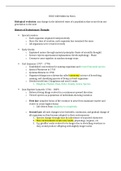Class notes
BIOL 2400 Midterm notes
- Course
- BIOL 2400 (BIOL2400)
- Institution
- University Of Guelph (U Of G )
This includes a summary of everything you must know for the BIOL 2400 midterm. Includes class notes and questions from the actual midterm with solutions.
[Show more]



